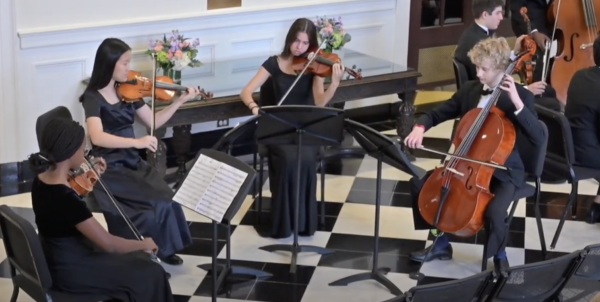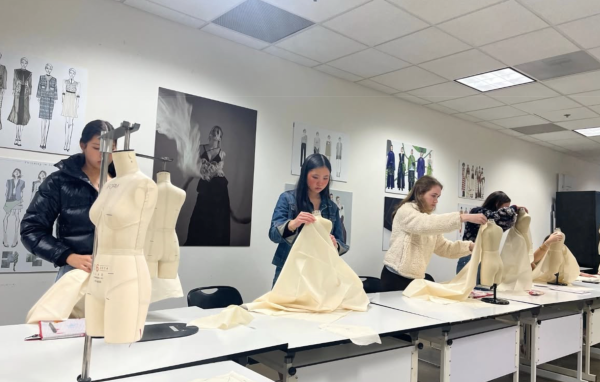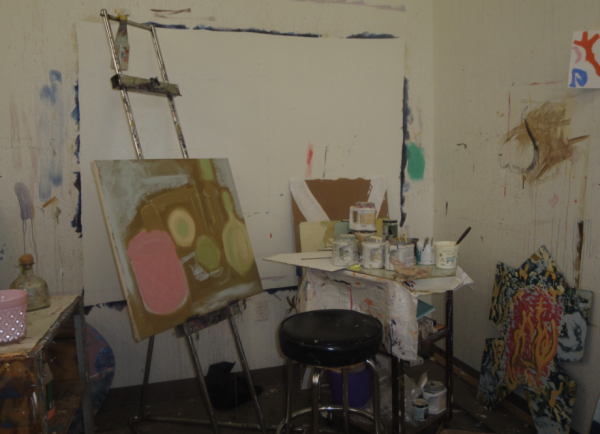Portfolio class visits Yayoi Kusama’s Infinity Mirrors at the High
Portfolio: Drawing & Painting students recently embarked on a field trip to the High Museum to view artist Yayoi Kusama’s breathtaking and critically acclaimed exhibit, Yayoi Kusama: Infinity Mirrors. This immersive exhibit culminates twenty years of Kusama’s hard work and is open to the public until Feb. 17. With the use of a variety of materials, such as mirrors, sculptures, and LED lights, the beauty of this sensational exhibit has left visitors in awe and astonishment.
While many know Kusama as an inspiring and influential artist, it is less common knowledge that she suffers from neurosis, a mental illness that causes anxiety, depression, or feelings of distress. From a young age, she began to use art to relieve her anxiety and help deal with the thoughts in her head. Today, people can see her mental illness and personal experiences reflected throughout her artwork. For example, Kusuma’s The Obliteration Room represents parental restrictions, which is intended to encourage people to disobey their parents. Because her parents were strict, she used her art to teach her audience to listen to themselves by allowing people to add stickers to the wall themselves. In a way, Kusuma has created art to give her audience her perspective of the world while living with a mental illness. Once upper school Portfolio teacher Pamela Martinez stepped into the mirrors, she experienced what it felt like when Kusuma was not able to get out of her own head.
“The idea of being in your own mind is infinite because you can’t get out of yourself,” said Martinez. “I thought that it was so beautiful and poetic to walk into those boxes and to think ‘this is what it feels like.’ It was truly beautiful.” Kusama’s clever placement of mirrors and materials in a small room creates an infinite effect where an object is depicted to go on for infinity. Each carefully thought out Infinity Mirror room creates an unique effect that captivates people’s attention.
There are six Infinity Mirror room-like boxes in the exhibit, each with a specific theme and name: The Souls of Millions of Light Years Away, All the Eternal Love I Have for the Pumpkins, Infinity Mirrored Room Love Forever, Love Transformed into Dots, The Obliteration Room, and Aftermath of Obliteration of Eternity. Depending on people’s artistic preferences, each room offers a different appeal for every individual.
AP Portfolio student Woods Curry thought the Aftermath of Obliteration of Eternity room was the most interesting. The Aftermath of Obliteration of Eternity is made up of LEDs, acrylic paint, mirrors, water, and more. The room shows golden lanterns flickering which seem to go on infinitely due to mirrors strategically placed around the room.
“The Aftermath of Obliteration of Eternity room was really cool—it was indescribable,” said Curry. “This room stuck out to me because one single object is repeated millions of times as opposed to some of the other rooms where there are a ton of different colors and materials.” Martinez decided to take her students to the exhibit because she thought it would be an opportunity to show them that artists can be successful, like Kusama, as opposed to the misconception that artists are often unemployed and struggling to make a living. Moreover, Martinez also wanted her students to see the many unique mediums that Kusama included in her pieces
“I think she’s a really good example of a contemporary artist who’s still alive and has sustained a career over essentially her entire life—that’s very, very rare,” said Martinez. “Her work continues to grow and she’s worked in many mediums. I wanted my Portfolio students to see what an exhibit looks like when somebody has worked in paint and sculpture, and also digitally, she has worked with mirrors, so she’s very unconventional.”
Taylor Boozer, another student of Martinez’s, believes that “a big part of learning about art is experiencing other people’s artwork. Ms. Martinez brought us to the exhibit because she especially values teaching us through examples of great artists like Yayoi Kusama.” As one of the greatest artists to come out of Japan, Kusama and her artwork have inspired students and teachers at Westminster. Visiting the exhibit has changed the way they perceive art and they are now considering adopting one of her many techniques into their own pieces.
“As a drawing and painting student, repetition is one of those things that is really important to keep in mind,” said Curry. “For me, personally, I think that her repeated patterns and other elements all definitely are incorporated into some of my own art. But most importantly, I think that her use of filling a space to be interactive is really cool and new.” Although the Infinity Mirrors exhibit has not struck inspiration for Martinez quite yet, she admires the way Kusuma works with watercolor and juxtaposes colors.
“I loved her watercolors and the way she uses color,” said Martinez. “In class, we talked about the way she juxtaposed colors so that they become a visual contrast causing them to vibrate. She uses colors in a way that stimulates your eye.” The Infinity Mirrors exhibit has received much global attention and praise. Kusuma’s art allows her audience to experience the way she views life with a mental illness, an eye opening opportunity for people who have had the chance to visit her exhibit. The exhibit has not only expanded the way Portfolio students view art as a vehicle to express emotion, but it has also inspired them to include new mediums and elements in their future art pieces.



